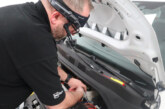
Replacing a broken or damaged windscreen is a skilled job and, when the vehicle concerned is a bus or coach, additional factors demand special attention. Henkel explores the things that you need to keep in mind.
The size, weight, and orientation of the windscreen all bring their challenges and the cost penalty of screen breakage during the installation process can be substantial. These considerations have prompted many commercial vehicle workshops to subcontract all direct glazing work to specialist glass fitting companies. However, thanks to developments in glass adhesive systems, the option to bring the process in-house is now eminently feasible.
The new formulations have made direct glazing a stable, reliable and workshop-friendly process that provides many commercial benefits. For an independent workshop serving the commercial vehicle sector it adds value to overall service and provides a valuable income stream. It also ensures the workshop’s own quality standards are applied and that repair time is much more controllable.
For Stagecoach – Britain’s biggest bus, coach, and tram operator – in-house windscreen replacement has also given it greater control over costs, both in terms of the process itself and getting vehicles back on the road quicker to minimise service disruption.
Stagecoach Group runs its transport services in the UK via a network that comprises regional hubs. The decision on whether direct glazing is conducted in-house is largely determined by the size of the depot and its corresponding maintenance team; currently 18 regions throughout the UK have adopted this option.
The direct glazing adhesive system that has made this possible is from Henkel and its selection was based on Stagecoach’s long-established positive experience with another Henkel Teroson product that had saved the company time and money.
Speedy re-sealing
Historically, in the event of a windscreen leak, the vehicle in question had to be temporarily taken out of service as the sealant Stagecoach used at the time required the substrate to be completely dry before re-application.
By changing to Teroson RB 4120 Elastic, a bead of new sealant can be applied even when there is moisture on the windscreen so the repair can be done quickly and at any time, ensuring the bus is back on the road safely as soon as possible.
It is a black, air-drying sealant paste based on artificial resins and synthetic rubber with a low solvent content. Applied from a manual Staku hand-gun, the sealant remains permanently plastic and is highly resistant to ageing and weathering.
Stagecoach realised that further cost and time savings could be achieved by undertaking windscreen replacement in-house where resources permitted. The company, therefore, worked with Henkel to identify the best product for the job and decided on Teroson Bond 60 True Primerless windscreen adhesive.
Cost- and time-efficient
Teroson Bond 60 True Primerless is one in the family of TEROSON products to be recently re-branded to highlight their safety credentials. As its name suggests, this adhesive is generally used without primer but, for Stagecoach Group, single-step application was not the primary benefit of this product.
As with all vehicles, a windscreen on a bus or coach contributes to the higher structural strength of the body. Of course, the windscreen is much heavier and generally sits vertically in the aperture making handling and placement a testing process.
“For Stagecoach Group, the key attribute of Teroson Bond 60 True Primerless is its initial green strength by comparison with other products in our range,” explains Henkel’s Barry Lewis. “When installing a more cumbersome screen, having good positional tack and initial stiffness is clearly a big advantage.”
As well as being heavier, a bus windscreen is exposed to much higher vibration than a windscreen on a car so the adhesive must be super-strong to maintain a safe bond. For this reason, Stagecoach underpins the performance of Teroson Bond 60 True Primerless with stringent preparatory measures including the application of Teroson All-in-One Primer.
An important benefit of applying primer is that it reveals any contaminants that may remain on the frame; it bubbles-up in their presence. This provides an extra safeguard that conditions are optimal for the best possible bond.








